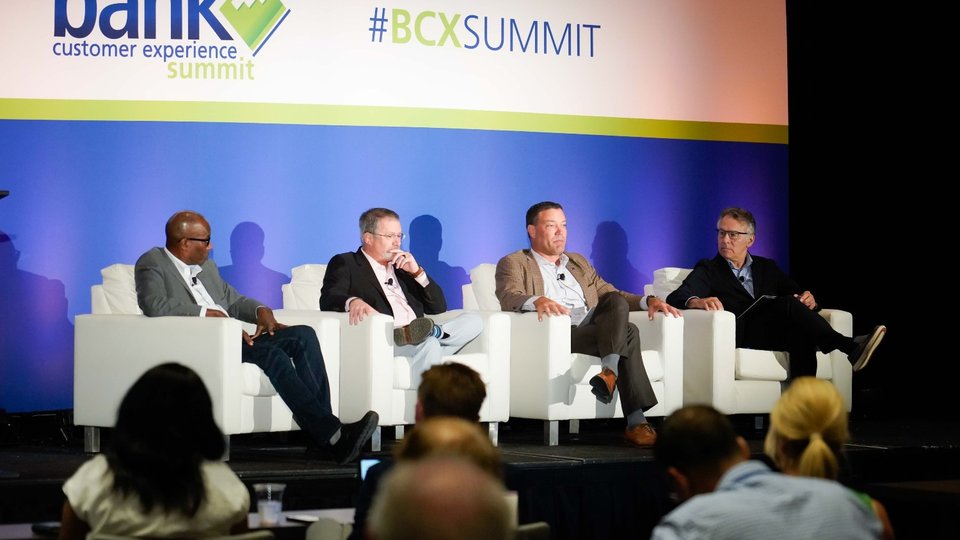Bank Customer Experience (BCX) Summit
Avoiding banking transformation pitfalls
A panel at the Bank Customer Experience Summit addressed how to avoid banking transformation pitfalls.

September 27, 2024 by Bradley Cooper — Editor, ATM Marketplace & Food Truck Operator
It's one thing to have big ideas about improving the customer experience. It's quite another to execute those ideas, as there are many potential pitfalls during CX transformations. A panel at the Bank Customer Experience Summit, held in Charlotte, North Carolina from Sept 9 to 11 examined how banks can avoid potential pitfalls and successfully transform their branches and banks.
Jean-Pierre Lacroix, president of Shikatoni Lacroix Design, moderated the discussion with Marbue Brown, founder of the Customer Obsession Advantage, Stephen Griffin, SVP of Branch and ATM distribution planning at Regions Bank and Chris Manske, SVP and director of retail network management at U.S. Bank.
Lacroix said that although "the future is here" for banks, "It's just not equally distributed." This can be particularly seen in Europe and Asia, where branches have shrunk in size, the majority of traditional transactions are done in ATMs and the branch has become more advice focused.
One potential pitfall addressed is embracing the digital while ignoring the physical.
"The digital format will continue to be valuable," Mankse said. However, he also pointed out that the "branch is the place where advice is given." As a result, banks need to find ways to "engage in more meaningful conservations with customers."
Griffin agreed, pointing out that digital channel should complement the branch. "When you look at the customers when they are choosing a bank, digital is very important to them but for heavily digital users, the branch is important to them."
As a strategy, he said that when Regions closes branches, it takes that money and reinvests it into other branches in the right locations, because customers need to have access to both ATMs and guidance from bankers.
Brown pointed out that if you look beyond banking to digital businesses like Amazon, they are also creating physical connections, such as being able to return items at Kohls and integration with Whole Foods.
However, there are several challenges to building these transformations in branches due to both costs and buy in from the entire retail team.
"You have to drive some type of collaborative consensus to align with your retail teams," Mankse said.
Griffin pointed out it's a very capital intensive process, especially with older branches. Costs haven't gone down with construction materials, which is very difficult for older branches.
"How do we reface our branches, make them better?" Griffin said. This also goes towards finding the right associates who can deliver advice to customers, which is also a cost to consider.
Brown said that in order to deliver these transformations, banks need to have a clearly defined goal.
"You have to a clear North Star. It can't be ambiguous and everyone needs to be mobilized by that North Star. The mobilization is not one in done communication it's surround sound communication," Brown said.
When looking at how banks can meet the needs of customers with their branches, Griffin said that it's about delivering convenience.
"During COVID, people thought branches are dead. What really happened is it became a complementary tool," Griffin said. He said that while customers want good digital tools, they also want access to ATMs, branch advice. They want what's convenient. As a result, banks need to keep a close eye on customer trends and think ahead: not necessarily try to deliver the branch of the future but instead the "branch of next year."
Brown said it's not enough to talk about giving advice, you need to make sure you're giving the right advice at the branch.
"You need to be super intentional about it. What kind of advice do customers need? Generally folks are not coming out of school financial literate. They don't understand the basics of 401ks, 529s, saving for college," Brown said.
However, many branch employees are not equipped to handle these topics. "Your typical employee who's been in the branch hasn't been accustomed to engaging customers on these sort of topics. They need tools, ways to initiate conversations," Brown said. "You can redesign the branch and if you don't invest time into equipping the employees to engage customers, you're not going to get the most out of your investment there."
Mankse agreed, adding that you need to survey your employees about the transformation to gain their input.
Lacroix said that it's key to ensure that employees know that the bank cares about them so they are "set up to succeed."
The panelists said that it's important to eliminate anxiety for employees around the transformation and customers who may be confused by the changes in the branch.
Mankse said you need a "choreography team" who can greet customers and familiarize them with the new branch and services. Griffin agreed, saying you need employees available to train customers on how to use self-service tools in the branch such as ITMs.
Bringing all this information together, Brown said that banks must have a North Star that can measure the impact of these transformation campaigns. It should measure inflows and outflows, customer satisfaction scores and whether the bank is attracting new customers.
"You shouldn't be playing checkers, you need to play chess and think strategically," Brown said.








